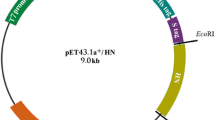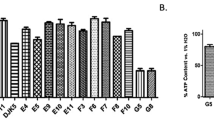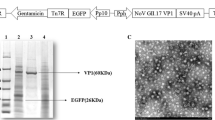Abstract
The lack of specific antiviral therapy and complications associated with the existing peste des petits ruminants (PPR) vaccines accentuates the search of novel antiviral blocking agents in order to curtail the PPR infection at initial level. The synthetic hemagglutinin–neuraminidase (HN) homologous peptides may compete with the natural HN protein of PPR virus for binding to signaling lymphocytic activation molecule (SLAM) receptor, consequently, may disrupt peste des petits ruminants virus (PPRV) at entry level. Therefore, insilico analysis, synthesis, purification and subsequent characterization of HN homologous peptides were conducted in this study. The HN homologous peptides were synthesized by means of solid phase chemistry and were purified by reversed-phase-high performance liquid chromatography. The mass as well as sequence of HN homologous peptides were assessed by mass spectroscopy while its secondary structure was elucidated by circular dichroism spectroscopy. The binding (interaction) efficacy of HN homologous peptides with PPRV antibodies was assessed via indirect enzyme linked immunosorbent assay, visual detection test (red wine to purple), bathochromic shift under UV–Vis spectrophotometry and lateral flow immunochromatographic strip test. The antiviral properties and cytotoxicity of these peptides were also assessed in B95a cell line with changes in cytopathic effect and titer of PPRV (Sungri/96). The presence of green fluorescein isothiocyanate over the B95a cell surface pointed towards the binding of HN homologous peptides with surface SLAM receptor. Moreover, the intact beta sheet configuration in water and lower cytotoxicity [cytotoxic concentration 50 (CC50) > 1000 µg/ml] of these peptides signifies its in vivo use. Among HN homologous peptides, the binding efficacy and antiviral properties of pep A was relatively high in comparison to pep B and Pep ppr peptides. The prerequisite concentration of HN homologous peptides (pep A = 12.5 µg/ml; pep B = 25 µg/ml; pep ppr = 25 µg/ml) to exemplify its antiviral effect was much lower than its CC50 level. Hence, this study signifies the therapeutic potential of synthetic HN homologous peptides.










Similar content being viewed by others
Data Availability
The original contributions presented in the study are included in the article/supplementary materials, further inquiries can be directed to the corresponding author/s.
References
Baron MD, Diop B, Njeumi F, Willett BJ, Bailey D (2017) Future research to underpin successful peste des petits ruminants virus (PPRV) eradication. J Gen Virol 98(11):2635–2644
Varshney R, Varshney R, Chaturvedi VK, Rawat M, Saminathan M, Singh V, Singh R, Sahoo M, Gupta PK (2020) Development of novel iron-regulated Pasteurella multocida B: 2 bacterin and refinement of vaccine quality in terms of minimum variation in particle size and distribution vis-a-vis critical level of iron in media. Microb Pathog 147:104375
Diallo A, Minet C, Le Goff C, Berhe G, Albina E, Libeau G, Barrett T (2007) The threat of peste des petits ruminants: progress in vaccine development for disease control. Vaccine 25(30):5591–5597
Sen A, Saravanan P, Balamurugan V, Rajak KK, Sudhakar SB, Bhanuprakash V, Parida S, Singh RK (2010) Vaccines against peste des petits ruminants virus. Expert Rev Vaccines 9(7):785–796
Kumar N, Chaubey KK, Chaudhary K, Singh SV, Sharma DK, Gupta VK, Mishra AK, Sharma S (2013) Isolation, identification and characterization of a peste des petits ruminants virus from an outbreak in Nanakpur, India. J Virol Methods 189:388–392. https://doi.org/10.1016/j.jviromet.2013.03.002
Root MJ, Steger HK (2004) HIV-1 gp41 as a target for viral entry inhibition. Curr Pharm Des 10(15):1805–1825
Zheng BJ, Guan Y, Hez ML, Sun H, Du L, Zheng Y, Wong KL, Chen H, Chen Y, Lu L, Tanner JA, Watt RM, Niccolai N, Bernini A, Spiga O, Woo PC, Kung HF, Yuen KY, Huang JD (2005) Synthetic peptides outside the spike protein heptad repeat regions as potent inhibitors of SARS-associated coronavirus. Antivir Ther 10(3):393–403
Kim DH, Ni Y, Lee SH, Urban S, Han KH (2008) An anti-viral peptide derived from the preS1 surface protein of hepatitis B virus. BMB Rep 30(9):640–644
Seth S, Shaila MS (2001) The fusion protein of Peste des petits ruminants virus mediates biological fusion in the absence of hemagglutinin–neuraminidase protein. Virology 289(1):86–94
Lovell SC, Davis IW, Arendall WB 3rd, de Bakker PI, Word JM, Prisant MG, Richardson JS, Richardson DC (2003) Structure validation by Calpha geometry: phi, psi and cbeta deviation. Proteins 50(3):437–450
Sajjanar B, Kakodia B, Bisht D, Saxena S, Singh AK, Joshi V, Tiwari AK, Kumar S (2015) Peptide-activated gold nanoparticles for selective visual sensing of virus. J Nanopart Res 17:1–9
Merrifield RB (1963) Solid phase peptide synthesis. I. The synthesis of a tetrapeptide. J Am Chem Soc 85(14):2149–2154
Reed LJ, Muench H (1938) A simple method of estimating 50% endpoints. Am J Epidemiol 3:493–497
Sarkar J, Sreenivasa BP, Singh RP, Dhar P, Bandyopadhyay SK (2003) Comparative efficacy of various chemical stabilizers on the thermostability of a live-attenuated peste des petits ruminants (PPR) vaccine. Vaccine 21(32):4728–4735
Ramakrishnan MA (2016) Determination of 50% endpoint titer using a simple formula. World J Virol 5(2):85–86
Kumar N, Maherchandani S, Kashyap SK, Singh SV, Sharma S, Chaubey KK, Ly H (2014) Peste des petits ruminants virus infection of small ruminants: a comprehensive review. Viruses 6(6):2287–2327
Langedijk JP, Daus FJ, van Oirschot JT (1997) Sequence and structure alignment of Paramyxoviridae attachment proteins and discovery of enzymatic activity for a morbillivirus hemagglutinin. J Virol 71(8):6155–6167
Pawar RM, Raj GD, Kumar TM, Raja A, Balachandran C (2008) Effect of siRNA mediated suppression of signaling lymphocyte activation molecule on replication of peste des petits ruminants virus in vitro. Virus Res 136(1–2):118–123. https://doi.org/10.1016/j.virusres.2008.04.026
Tatsuo H, Ono N, Yanagi Y (2001) Morbilliviruses use signaling lymphocyte activation molecules (CD150) as cellular receptors. J Virol 75(13):5842–5850. https://doi.org/10.1128/JVI.75.13.5842-5850.2001
Tangye SG, Phillips JH, Lanier LL (2000) The CD2-subset of the ig superfamily of cell surface molecules: receptor-ligand pairs expressed by NK cells and other immune cells. Semin Immunol 12(2):149–157. https://doi.org/10.1006/smim.2000.0217
Henning G, Kraft MS, Derfuss T, Pirzer R, de Saint-Basile G, Aversa G, Fleckenstein B, Meinl E (2001) Signaling lymphocytic activation molecule (SLAM) regulates T cellular cytotoxicity. Eur J Immunol 31(9):2741–2750.
Zhou P, Jin B, Li H, Huang SY (2018) HPEPDOCK: a web server for blind peptide-protein docking based on a hierarchical algorithm. Nucleic Acids Res 46(W1):W443–W450
Ding Y, Jiang Z, Saha K, Kim CS, Kim ST, Landis RF, Rotello VM (2014) Gold nanoparticles for nucleic acid delivery. Mol Ther 22(6):1075–1083
Velasco-Aguirre C, Morales F, Gallardo-Toledo E, Guerrero S, Giralt E, Araya E, Kogan MJ (2015) Peptides and proteins used to enhance gold nanoparticle delivery to the brain: preclinical approaches. Int J Nanomed 10:4919–4936
Sangabathuni S, Murthy RV, Chaudhary PM, Subramani B, Toraskar S, Kikkeri R (2017) Mapping the glyco-gold nanoparticles of different shapes toxicity, biodistribution and sequestration in adult zebrafish. Sci Rep 7(1):4239
Jeong WJ, Bu J, Kubiatowicz LJ, Chen SS, Kim Y, Hong S (2018) Peptide-nanoparticle conjugates: a next generation of diagnostic and therapeutic platforms? Nano Converg 5(1):38
Agrawal A, Varshney R, Gattani A, Kirthika P, Khan MH, Singh R, Kodape S, Patel SK, Singh P (2020) Gold nanoparticle based immunochromatographic biosensor for rapid diagnosis of Mycobacterium avium subspecies paratuberculosis infection using recombinant protein. J Microbiol Methods 177:106024
Dineva MA, Candotti D, Fletcher-Brown F, Allain JP, Lee H (2005) Simultaneous visual detection of multiple viral amplicons by dipstick assay. J Clin Microbiol 43(8):4015–4021
Dziąbowska K, Czaczyk E, Nidzworski D (2018) Detection methods of human and animal influenza virus-current trends. Biosensors 8(4):94
Posthuma-Trumpie GA, Korf J, van Amerongen A (2009) Lateral flow (immuno) assay: its strengths, weaknesses, opportunities and threats. A literature survey. Anal Bioanal Chem 393(2):569–582
Daar ES, Li XL, Moudgil T, Ho DD (1990) High concentrations of recombinant soluble CD4 are required to neutralize primary human immunodeficiency virus type 1 isolates. Proc Natl Acad Sci U S A 87(17):6574–6578
Lambert DM, Barney S, Lambert AL, Guthrie K, Medinas R, Davis DE, Bucy T, Erickson J, Merutka G, Petteway SR Jr (1996) Peptides from conserved regions of Paramyxovirus fusion (F) proteins are potent inhibitors of viral fusion. Proc Natl Acad Sci U S A 93(5):2186–2191
Ammendolia MG, Agamennone M, Pietrantoni A, Lannutti F, Siciliano RA, De Giulio B, Amici C, Superti F (2012) Bovine lactoferrin-derived peptides as novel broad-spectrum inhibitors of influenza virus. Pathog Glob Health 106(1):12–19
McGaw LJ, Elgorashi EE, Eloff JN (2014) 8-Cytotoxicity of african medicinal plants against normal animal and human cells. Toxicol Surv Afr Med Plants 8:181–233
Sreenivasa BP, Singh RP, Mondal B, Dhar P, Bandyopadhyay SK (2006) Marmoset B95a cells: a sensitive system for cultivation of Peste des petits ruminants (PPR) virus. Vet Res Commun 30(1):103–108. https://doi.org/10.1007/s11259-005-3200-5
Acknowledgements
The authors are thankful to the Director ICAR-IVRI for providing the necessary facilities for carrying out this research work.
Funding
This work was not supported by any public agency or grants.
Author information
Authors and Affiliations
Contributions
AA: Conceptualization, data curation, formal analysis, investigation, methodology, writing—review and editing. RV: Data curation, formal analysis, investigation, methodology, writing—original draft. AG, MHK, RG, KSS and SKP: Formal analysis, methodology. RPS: Supervision, validation, visualization. PS: Conceptualization, data curation, funding acquisition, investigation, project administration, resources, supervision, validation, writing—review and editing. All authors reviewed the manuscript.
Corresponding author
Ethics declarations
Competing Interests
The authors declare no competing interests.
Additional information
Publisher’s Note
Springer Nature remains neutral with regard to jurisdictional claims in published maps and institutional affiliations.
Supplementary Information
Below is the link to the electronic supplementary material.
Rights and permissions
Springer Nature or its licensor (e.g. a society or other partner) holds exclusive rights to this article under a publishing agreement with the author(s) or other rightsholder(s); author self-archiving of the accepted manuscript version of this article is solely governed by the terms of such publishing agreement and applicable law.
About this article
Cite this article
Agrawal, A., Varshney, R., Gattani, A. et al. Development of Hemagglutinin–Neuraminidase Homologous Peptides as Novel Promising Therapeutic Agents Against Peste des Petits Ruminants Virus. Protein J 42, 685–697 (2023). https://doi.org/10.1007/s10930-023-10134-4
Accepted:
Published:
Issue Date:
DOI: https://doi.org/10.1007/s10930-023-10134-4




